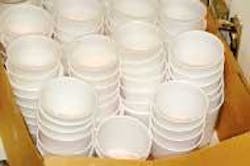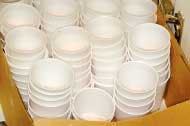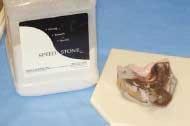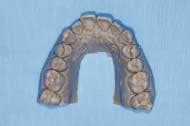HOW TO PROFIT FROM…bleaching: Predictable, profitable, and positive
By Jack D. Griffin Jr., DMD
It wasn't long ago when we dentists told people, "If you pick a shade too light for your new teeth, they'll look fake." We steered them away from B1 on the shade guide because it was "too light." How old-fashioned! There was even a time when we actually tried to make the new teeth the same color as the ones they already had. Today, there is no such thing as "too light" and "natural" seems too dark to even consider.
Bleaching certainly is a reality in everyday practice for many of us. It has become predictable, profitable, and receives a positive public perception. It is amazing that some practitioners think bleaching is a waste of time or of no advantage to the patient or the practice. We charge $150 for the first arch and $100 for the second arch. That's less than most offices charge, but it is still quite profitable. And, we collect more in indirect income than we do for the bleaching itself. We do more anterior fillings, bonding, crowns, and even orthodontics because of the patients' increased interest in other aesthetic procedures that bleaching often promotes.
The really neat thing about bleaching is that it sells itself. Patients really want it; it's reasonably predictable; it stimulates patients to want other procedures; and it's easy for the staff to do. The key - as with many procedures done in any efficient office - is to have a well-trained, knowledgeable staff that handles the majority of the duties and explanations. The dentist oversees the staff and the procedure, handles unusual questions or problems, and stays up on the research and techniques.
Since dentists think bleaching should continue to be managed, supervised, and dispensed inside a dental office, we owe it to our patients to be "up" on the latest research and recommendations by actual dentists and researchers. We should not get our bleaching information from salespeople, the Ladies Home Journal, or from "Oprah." At the very least, all dentists should consider subscribing to Reality, CRA Newsletter, or other independent evaluators so that we aren't swayed quite so much by the hype that comes from ads and manufacturers' promotions.
Sparking an interest = smile art
There isn't much of a need to "push" bleaching. Most of it is sold before the patient gets to our office. TV ads, magazines, and even talk shows are doing the majority of the marketing for us. Usually, during a hygiene appointment, the patient will ask the hygienist about bleaching. Often, the conversation starts like this: "Hey, nurse, do those Crest Strips work?" or "Will my teeth get 20 shades whiter with that $19.99 paste on that midnight TV infomercial?" Bleaching is one of the few dental procedures that patients actually ask for without high-tech diagnostics and professional coercion.
"Smile art" (as I call it) is cool these days. Many practitioners have walls filled with before-and-after smiles that may influence a patient's decision on restorative procedures. But, as effective as photos can be, walking billboards are even better! The entire staff should bleach their teeth, because they are your best marketing tools for the benefits of bleaching! They alone will "sell" most of the bleaching. And, not only will their pearly whites glow, they will gain the experience needed to answer basic questions patients ask. This will make the entire procedure more efficient.
Each hygiene room should have before-and-after photos of patients who have had their teeth bleached. New patients can see for themselves what your aesthetic results look like. Most of the big bleaching suppliers will provide you with nice brochures, posters, and charts that can be displayed subtly in the reception area and treatment rooms; but, there is nothing like showing off your own cases. With digital cameras and inkjet printers, it is easy for you to promote your work. Then, when you arrive in the hygiene room, you usually just need to reinforce what the hygienist has already told the patient.
Efficient bleaching = using the staff
The best time to give a patient a service they really want is right now! The staff should be able to deliver the tray, instructions, and bleaching material about 15 minutes after the order was taken. This leaves much less time for the brain to try to rationalize the emotion out of the treatment. Also, the fewer appointments needed for any procedure, the more efficient the office can be. Take the impression, pour it up, explain the procedure, and deliver the goods the day the patient decides he or she wants to bleach. As soon as the patient says, "I'm ready to whiten my teeth," we give them a sea-weed extract and water lunch!
We have alginate premeasured in flexible plastic cups (see Figure 1 below), stored in a central location next to the impression trays. This saves time and eliminates the mess, since alginate doesn't need to be scooped, measured, and slopped on the counter and floor. We just add water to the cup, mix, and load the tray (Figure 2). Then, the cup is thrown away and the only thing remaining to be cleaned is the spatula. This saves mixing those old alginate chunks into future impressions. If the request for tooth-whitening is made at the hygiene appointment, the hygienist takes the impression unless an assistant is free. It usually is faster for a hygienist to take the impression than to hunt down an available assistant.
The doctor and staff should work together to establish a systematic protocol that can be consistently followed consistently. Take photos showing how you want impressions to look, how models are to be trimmed, how trays are to be cut out, and how you want the tray filled with bleach (Figures 3, 4, 5, 6, and 7). Then, print the photos and display them in the lab so the staff has a quick way to see how you want things to be. done. Of course, you can skip this step if you like to be frustrated, enjoy yelling at your staff, and/or like patients to return to the office with problems.
Pouring up the impression is done by whoever has the time - the assistant, hygienist, or even the doctor. We use Speed Stone, which sets rock-hard in about five minutes. Whip Mix Quickstone is another good choice.
During this time, the assistant or hygienist explains the procedure to the patient, answers any questions, and selects a shade. An assistant then heats, sucks, and trims the tray according to the established protocol.
Is our office the only one where goofy stuff happens to lab work? Fast delivery is better for a lot of reasons. It beats putting the alginate in the lab sink and finding it the next Monday hiding under a dried-up paper towel. Or, maybe someone forgets to separate the model from the impression for several days, which calls for a "recovery attempt." An assistant soaks the impression in water for a few hours to "soften things up," only to snap the teeth off when separating the tray anyway. If we find the pieces on the floor, hopefully super glue will hold well enough so that the tray will fit the patient reasonably well. We even "lost" a lab case once! If we're living right, the patient won't blow chunks again when we retake the impression. Or, maybe, we just forgot to make the goofy thing until the patient walked in for the next appointment. We scramble really fast when the receptionist yells, "Hey you guys, got that bleaching tray ready for Mrs. Gates you were supposed to make last week?"
Show the patient exactly how much bleach to put in the tray and where to put it. If you don't do this, patients may use a month's supply of bleach in two nights! Answer questions honestly. Explain when to bleach and how long to do it. The gums can turn white near where the tray is placed. For other patients, the gums may feel a bit "achy," and the teeth may be sensitive for a while. Stress that these problems are temporary in nature and usually are resolved with some time off from bleaching or by changing to a weaker bleaching concentration. If sensitivity persists, provide a neutral fluoride to go inside the tray in place of bleach. Don't forget to point out that dental work will not change color during bleaching. This is "duh" to the dental staff, but patients may not understand this concept.
Practice marketing = give it away!
There is a biblical principle that says the more we give, the more we get. That certainly can apply in dentistry. Schools, ladies' clubs, charities, ball teams, and many other groups are always looking for things to auction off or sell to raise money. Giving away bleaching is a terrific marketing tool; it lets the community know just how cutting-edge your practice is. Donate a "Free arch of Bleaching" certificate.
Bleaching is a great thing for an office to use as a give away because people want it, it is easy and quick to perform, and the overhead costs are small. Sure, you could have the local middle-school children raffle off a free molar endo to raise money for their field trip, but that probably won't turn out to be much of a practice-builder. When you donate the bleaching service, you may earn a new patient if you and your office staff impress the winner. Welcome these new patients to the office, give them a tour, and just be pleasant to them - no hard dental selling! Just being friendly and professional will give you a good name in the community and help build your the practice.
Some offices hold a "drawing" once a month for those patients who maintain regular recalls. The office pulls out a name, calls the patient, and gives a free arch of bleaching as a reward for being a faithful patient. How about a free bleaching to the patient who refers the most new patients over a six-month period? Some dentists take a portion of the money they make from some bleaching cases and give it away to help local children's charities. If you inconvenience a patient in any way - i.e., running very late, losing an impression, messing up billing, backing your SUV into their BMW - offer a free bleaching as compensation. Just the gesture will impress them. Remember, there are greater rewards in dentistry than simply a bigger bank account.
Materials and methods = fast, slow, or inbetween
So many systems, so little time! There are three basic categories:
- Take-home bleaching
- In-office power bleaching
- Office light-assisted home bleaching
Is bleaching "better" going fast with some cool, high- tech light? Is sensitivity less of a problem if we go slower? Will teeth get brighter with hydrogen peroxide or carbamide peroxide? If we do a potent booster-bleaching at the office before sending the patient home, will the cost in materials and office time be worth it? Do we continue to use higher and higher percentages of bleach until the gingiva sloughs? Do we charge for a gingivectomy if it does? Are reservoirs recommended just so companies can sell more block-out resin and bleaching materials? Does adding fluoride or potassium nitrate help with sensitivity?
Generally, hydrogen peroxide bleach is stronger than carbamide peroxide at the same percentage strength. Carbamide peroxide is broken down into hydrogen peroxide and urea on the teeth and works by an oxidation/reduction action and uptake by the enamel. Potassium nitrate and fluoride can reduce sensitivity and may work by reducing fluid flow through the tubules.
They may be important ingredients in your selection of materials. It seems that the viscosity of the material and the time the material is against the tooth is more important in achieving good bleaching results than the quantity of gel, so reservoirs don't appear to be needed.
There is no doubt that light-assisted and power bleaching has a niche. Some patients hate to wear trays and with the "I gotta have it NOW!" mentality in society today, there are indications for its use.
Nite White and Day White from Discus, Opalescence from Ultradent, Zaris™ from 3M™ ESPE™, and Rembrandt® from Den-Mat™are all excellent materials that are easy and effective to use. These companies provide great kits that have all of the bleaching materials, shade guides, tray cases, carrying cases, and other goodies. This makes it easier for the staff and the patient. These materials are highly rated, well-researched, and easy to use.
We generally offer two basic options for patients - alpha 16 to 22 percent carbamide peroxide (Discus Nite White Xcel2"Z") for those patients who want to wear the tray to bed all night, or
Opalescence® from Ultradent also is a good choice for bleaching. It has great materials and syringes, as well as very good flavors (melon, banana, and mint). Higher- powered, 35-percent hydrogen peroxide bleaches, like Opalescence® Xtra™ Boost, definitely lighten teeth in one office appointment without a fancy light. This material provides a vehicle for in-office, bleach-boosting and works well for internal bleaching - perhaps with less chance of root resorption than the old "walking bleach" technique.
Bleaching leads to other work
Bleaching itself is financially profitable, but even more so if it leads to other aesthetic work. In our office, we have many patients who just kind of float along with gnarly looking composites, a diastema, or a grungy, old anterior crown. We suggest some cosmetic work at recall appointments, but these patients insist on looking like the people on the "Jerry Springer Show."Then, one day, the vanity bug
hits them and they decide to cruise through the rest of life with better-looking choppers. Often, bleaching is their first cosmetic experience. These patients get excited with their new smiles.
We stress that we can't guarantee how much lighter teeth will get. We do tell patients, though, that if their teeth don't whiten at least two shades on the Vita shade guide, we will give them their money back, as long as they have followed our instructions. For patients who have distinct multi-colored teeth, deep tetracycline-like stains, or mottled teeth, we inform them that bleaching may be uneven and that bonding may be needed later to "even out" the color.
Sometimes, a patient will try bleaching and, because of uneven color, will elect to do composite or porcelain veneers. At other times, we've had patients ask us about bleaching because they saw our brochures or photos. Then, they later decided to do other restorative work, such as composite veneers. All of this is a result directly or indirectly from bleaching.
Develop bleaching technique guide for staff members
Write a technique guide for the staff to follow on every bleaching patient:
- Make a treatment plan = patient signs and agrees to fee
- Hygienist or assistant takes impression = fast-set alginate, premeasured cups
- Pour-up = model made from fast-set stone in about five minutes.
- Explain procedure while stone is setting = explain and show how to use kit
- Explain bleaching options to the patient = all night or an hour once or twice daily
- Select a shade for patient's teeth = arrange Vita guide chromatically from light to dark
- Take photos = have patient hold shade tab next to teeth
- Give reasonable expectations = at least two shades lighter, perhaps much more
- Make suck-down tray = no reservoir, faster to make, and no benefit to patient
- Deliver tray, demonstrate use = like fertilizer, more is not better; show small amount needed on facial
- Have patient return for one-to-two-week follow-up = ask patient about the experience and any problems; answer questions
- Re-evaluate and schedule follow-up according to patient experience
10 basic questions patients ask about bleaching
Train the staff well and write a script to answer patients' most frequently asked questions about bleaching:
- How much material should I put in the tray?
- How long should I leave the tray in?
- How many days in a row should I bleach?
- What if my gums or teeth get sensitive?
- How often will I have to touch up the bleaching?
- What are the long-term effects on my teeth?
- How often will I have to buy more bleach?
- If I have trays from another office, can I buy bleach from you?
- What is the charge for more bleach?
- What if my dog eats my trays?
Have fun with bleaching! It is a great service to the patient because it is a simple, cost-effective way to make a drastic change in a smile. And, as a bonus, your practice just may grow from it!







